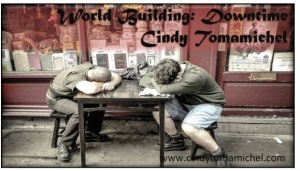Summer holidays last forever, especially if you are a child – or indeed a parent.
Weeks and weeks of sun drenched days with no planned activities. Sounds marvelous? But how are these to read about? Endless descriptions of sunsets or fishing or lolling about watching Netflix gets dull real fast.
So how do you handle it in your novel?

For the most part, people seem to manage it by frenetic activity – particularly high action adventure, such as Matthew Reilly. His heroes never eat, and only rest when they are dead. The plot drags you along relentlessly, and you flip pages, breathless with excitement. Many quest novels are the same, with very little downtime, or a chance for the all important second breakfast. There is always a monster just around the corner, and the questors hurl themselves forward with seemingly inexhaustible energy, and no need for toilet breaks.
And yet by the end of a high action novel, do you feel you know the characters? Did they survive long enough to gain some depth and back story, or are you forced to read several books in the series, desperate for the two lines of back story tidbits? These are extreme examples of plot driven novels, and usually make for exciting reading. They would most likely translate well into a movie, where internal dialogue is not wanted.
There are a few ways to add character depth as they hurtle through the plot. Andy McDermott in his Nina and Eddie archaeology adventure series does it with jokes and side quips during the action. At the end of a car battle, we know Eddie as he remembers his past, wise cracks with the bad guys, and rescues his wife, or is rescued by her. Another is a very brief introduction before the action. An old army buddy will open up a bit of the past, which will have an unexpected impact on the battle, and then the book.
Tag lines are another way. If a character repeats a phrase, or a physical gesture, then they are more easily remembered.
A series that manages high action quiet times is the Modesty Blaise series by Peter O’Donnell. During a caper, waiting for the bad guys to arrive, Modesty and Willie Garvin swap stories, and play verbal games. These endearing sections make the novels much more than mere crime action novels, as good as the action is.
A common fantasy ruse is the meal, and Tolkien uses party meals, Elven feasts, and prison meals as a way to highlight characters and species. Without ever seeing an orc, we know how nasty they are from their favourite foods. Gollum reaches new depths of awfulness and despair when he is forced to eat goblins in the depths of the caves. Compare this to the relief when they are safe at Beorn’s house, eating a simple meal of bread and honey. But they learn much during this meal, and gain a powerful ally.
Sci-fi down times are interesting, as they can highlight a lot of world building and what is normal and what is not. In the vast distances of space – is the time handled with deep sleep, multi generational ships, or busy work for shifts of people? What cultures develop as a result? In the second (and arguably the greatest) Aliens movie, the early awakening of the military and crew, exercise, and jokes shared by the crew sets the scene for their comradeship and teamwork when under threat. By the time the aliens pop up, we care about the human crew. If we went straight into the action, then it is a faceless bloodbath.
In “The Watch Below” by James White, the crew are trapped in a submerged vessel, and for generations, confined with little to do but exercise their minds and memories. This develops into an extraordinary culture where fictional characters and stories become a primary stabilising factor. This is contrasted to an alien multi generational ship, which suffers bloody battles and cultural degeneration. So downtime here was almost all there was, and White uses it as a tool that shapes the evolving culture. My story “When Words are not Enough” in Quantum Soul was influenced by this idea of multi generational confinement.
Downtime in a novel is also a good time for the reader to have a little break, to gear up for the next part. Let the reader into the placid or quietly fascinating parts of your world, and they will care more about your characters when they face an even greater danger, lurking while they relaxed, just out of sight…
Enjoy this blog? Have a think about signing up via my website or catch them as they fly around the ether on twitter or facebook. They will stay where they are pinned on pinterest.
For those that have not read Druid’s Portal yet, here is a link to the first chapter DruidsPortal
Scifi more your thing? Try my short stories in the anthologies Quantum Soul and Tales from Alternate Earths 2.
If you are keen to chat with other scifi peeps, then check out the Knights of the Scifi Roundtable facebook group and subscribe to their newsletter https://mailchi.mp/29fb30bca8e4/update-subscription
Short stories and poetry? Try the Rhetoric Askew anthologies: Mixed genre, Adventure or Romance
Tired from all that thinking? Try a 5 Minute Vacation: 5 Minute Vacation

